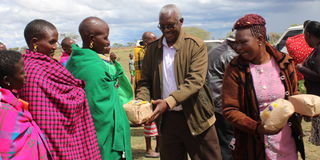How love and intermarriage transformed Laikipia village

Residents of Loroa village receive food donations.
In 2007, the Loroa area of Thome Location in Laikipia County was ravaged by intense tribal conflict fuelled by banditry and resource scarcity, resulting in loss of life and property.
Unresolved water and grazing conflicts meant that Loroa was one of the hotspots for banditry in Laikipia.
Locals also attributed the problem to the fact that sedentary agriculture and some large ranches had taken over or blocked access to historically common grazing and water points, leading to violent clashes.
For most locals, life was unbearable, with dozens displaced by the constant clashes pitting farmers against herders, with violence also blamed on climate change and the cycle of land politics and power.
Fifteen years on, locals cherish the peace they enjoy. The secret, they say, lies partly in intermarriages between the dominant pastoralists and farming communities.
The once troubled Loroa, 15 km from Rumuruti town towards Maralal town in Samburu, now stands as testament to the power of peace, proudly hosting Kikuyu, Samburu and Maasai communities.
What is fascinating is the seamless interaction between the locals, whose tribal origins are now indistinguishable. This is because most residents are eloquent and communicate in the three language.
Akaai Lokore, a resident, attributes linguistic diversity to intermarriages following peace talks that shattered the cycle of violence that once plagued the area.
“While some challenges still exist, we have learned that with peace, we can support each other. Our sons and daughters have intermarried, bringing stability and harmony since we are now family,” Lokore remarked.
Elders recall the turbulent years when Loroa was at the centre of bloody tribal conflicts, fuelled by banditry.
Lokope Mwangi, a village elder, recalls that politically-motivated clashes made Loroa almost uninhabitable.
Bandit attacks
“Bandits took advantage of politically-activated clashes and the situation escalated with bandit attacks until 2010. Every ambush soured relations further between the indigenous communities, each of whom suspected the attackers to be their neighbours," he says.
Teresiah Wambui, a leader highlights the positive impact of intermarriage on peaceful coexistence, despite challenges such as lack of schools, hospitals and water.
“The nearest primary school is 15 kilometres away and the nearest day secondary school, 20 km away. Our main source of livelihood is casual labour on farms situated more than 10 km away. Despite these challenges, we are grateful for the support of development partners," said Wambui.
Leleruk Esinyen, a village elder, recalls the inevitable blame game in the past for livestock losses during droughts and credits the transformative role of peaceful interventions.
Organisations such as Pillars of Mercy have played a key role in promoting peace and stimulating development projects in the community. Led by Paul Kufmann, the organisation has dug a borehole, initiated greenhouses and a boarding school, with a focus on modern agricultural practices to reduce livestock losses during droughts.
Joseph Warui, chair of the organisation’s Kenya chapter, emphasises the importance of educating pastoralist communities and outlines initiatives aimed at empowering the community for sustainable development.
Dennis Ndereba, a Youth Welfare Officer, emphasises the crucial role of youth in driving development initiatives. The overall goal is to make a significant contribution to food security, ecosystem restoration and climate adaptation.
Interventions like these have transformed Loroa Village into a beacon of peace, sustainable development and a united community looking forward to a brighter future.





